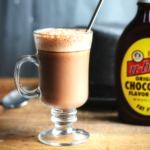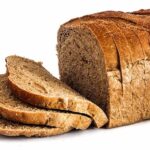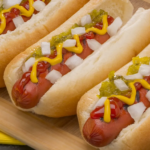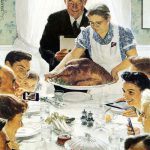food histories

American pokeweed is a flowering herbaceous perennial plant belonging to the Phytolaccaceae family. And while the leaves and stalks of this species are a nutritional powerhouse, high in vitamin A, C, iron, and calcium, its high toxicity will make humans extremely ill (perhaps even fatal) if not properly cooked.

This egg cream recipe comes from Peter Freeman and Gia Giasullo, co-owners of the Brooklyn Farmacy, located in the Carol Gardens neighborhood.

For the uninitiated, egg creams, despite their name, contain neither eggs nor cream.

It was 1812 America when Philadelphia scientist and horticulturist James Mease created the first tomato ketchup, but it was H. L. Heinz that turned it into a global condiment.

The Great Depression brought with it a number of major changes in the American food scene — how to acquire food, how to make it last, and how to turn the available limited ingredients into tasty, nutritious meals.

Bread is one of the oldest, most important, yet perhaps the most presumed foods in the world. In its simplest form, bread is wheat flour and water formed into a shaped dough and baked.

Over the past two centuries, the worldwide marketplace has seen the development of hundreds of soft drink brands. While many have enjoyed lasting success, many more have fallen to the wayside.

1795 Nicholas Appert discovered how to preserve foodstuffs for long period of time, although it took 14 years of trial and error. Yet it took another 50 years before anyone knew why the Appert’s method worked.

The term “Brunch” may have been created by British author Guy Beringer, it was on this side of the pond that its popularity grew.

The hot dog consists of a boiled, steamed, or grilled sausage, known as a wiener or frankfurter, tucked into a specially designed bun, usually dressed with condiments or toppings that can vary depending on your country, state, or locale.

Diners can be traced back to Walter Scott, a newspaper pressman at the Providence Journal who, in 1872, left the presses to sell late night coffee and sandwiches from a horse-drawn wagon.

If all of the Cracker Jack sold during that time were laid end-to-end they would circle the earth more than seventy-one times.

The first pumpkin pies were likely made by hollowing out the shell, filling it with milk, honey, and spices, then baking it in hot ashes.

The chimichanga is said to have been created not in Mexico but in Phoenix, Arizona.

Shepherd’s pie came about in the late 1700s as a way for frugal peasant housewives to use their leftover lamb, mutton, and other meats.

The first cheesecakes, known as “plakous,” were simply made using only flour, wheat, honey, and cheese.

Bread pudding can be traced back to the early 11th century as a way for frugal cooks to utilize leftover bread.

Well-decorated gingerbread houses became popular following the 1812 publication of the Brothers Grimm fairytale “Hansel and Gretel.”

One of my all-time favorites is a tuna salad sandwich–canned Albacore tuna packed in water with minced celery and onion, hard-boiled egg, a touch of garlic, and lots of America’s favorite condiment, mayonnaise. And though some of you may dislike, even hate mayo, I’m among the majority who wouldn’t think of having a ham and […]

My first exposure to a club sandwich was at the Rexall drug store next to the supermarket, where I worked after school and weekends. One Saturday the lunch counter waitress (yes, back then drug stores had lunch counters), a young hottie with whom I was totally infatuated suggested I buy the "daily special" to help […]

While my childhood was one of humble existence, we were not without some of the middle-class niceties of the times, thanks to a an extremely hard working father and a mother with the uncanny ability to stretch a dollar further than anyone I’ve ever known. Growing up, I loved just about everything that summer had […]

Why buy boxed cake mix when you can make your very own using simple ingredients you probably already have in your pantry?

Growing up in the mid-twentieth century, I observed first-hand a number of food innovations and convenience products that directly affected how the American housewife prepared the family meal. Arguably, the one product that brought about the biggest change was the invention of boxed cake mixes. I can remember when every pie and cake my mom […]

A lady recently asked me, “Chef, what’s your favorite food?” My reply was, “Breakfast foods. Bacon, eggs, omelets, biscuits and gravy–you name it.” Then, after a brief pause, “And pancakes. I love pancakes!” I’m not sure when my affinity for pancakes began. You’d think it would have been as a young child, but I don’t […]

Growing up, I was exposed to Jell-O in just about any way and every way one can imagine–molded, sliced, cubed up, chopped up, plain or mixed with fruit, cottage cheese, and all sorts of vegetables. It seems that every grandmother, mother, and daughter had their favorite Jell-O dish and an extreme compulsion to bring it […]

I’m not exactly sure when I had my first Reuben sandwich, although I believe it was at the lunch counter of a Skillern’s Drug Store when I was about 17 years old. What I do know is that it was love at first bite–the nuttiness of toasted rye, the sweet and sour sauerkraut mixed with […]

The sloppy joe began making its appearance in food columns, advertisements, and cookbooks in the early 1940s.

Several years ago, I did a stint as executive chef at a busy Texas hotel. Once or twice a month, usually after a busy Friday night, the kitchen staff and I would meet at Evelyn’s Café for a late-night breakfast before going home. Evelyn was known miles around for was her delicious three- layer carrot […]

Although it first began showing up on supermarket shelves in the early 60s where I grew up, I really don’t recall its popularity soaring until some twenty years later while I was cooking in New York City. It was there in the “big city” that I started to think, “Folks are so crazy about this […]

A few weeks back, I was watching Martha Stewart Bakes during which she made something I had never heard of in my forty-plus years as a chef–a Gooey Butter Cake. It seems this cake was invented during the Great Depression in the 1930s by a German-style bakery located on the St. Louis South Side. And […]

A couple of weeks ago while putting away the grocery order, my wife discovered the market had included two bottles of eggnog without her knowledge. When contacted about the error, the store manager explained they were given as apology for the unusually large number of out of stock items in our order. So later that […]

Some of my fondest childhood memories are centered around helping my mom in the kitchen. She was a terrific cook whose dishes, although simple country fare, were always flavorful and extremely well prepared. Among some of my favorite foods were those she made for holidays and other special occasions such as birthdays and church potluck […]

I was out with some friends at a popular fast casual chain restaurant that had just opened in Dallas when I first saw them on the appetizer menu–fried pickles. "FRIED PICKLES! Who the hell ever heard of fried pickles?" "You gotta try them," one member of the group said. "They’re great!" So being a curious […]

The major difference in a chess pie from other custard pies is most chess pie recipes call for a small amount of cornmeal or flour.

My wife, Maria, just loooves grits. Normally this wouldn’t be such a revolution, but she’s a born and bred Italian New Yorker. And, New Yorker’s do not eat grits. They eat farina, that creamy, smooth, rather bland breakfast portage known by many of us as cream of wheat. My wife Maria was certainly no exception. […]

I’ve always been a lover of cheese. Any kind of cheese–hard cheese, soft cheese, and numerous in-between varieties. While I certainly have my favorites, I can’t remember a cheese I’ve ever tasted that I wouldn’t eat. And I’ve tasted a lot of cheese. But last evening, my wife, who was reading a new cookbook, asked […]

As a youth of about eleven or twelve, I was somewhat coerced by my best friend Billy to join the Boy Scouts. Although this experience was extremely short lived by both of us, we did manage to stay in the troop long enough to go on our first (and Billy’s last) camping trip. As I […]

Some months ago while passing through Waco, Texas on a business related road trip, I couldn’t help but think about some of the historic events surrounding this small city named after Native Americans who once lived in the area. One of the most significant of these events is that Waco is the birth place of […]

As I’ve mentioned before, ours was a family of modest means. But my father worked hard to see that we were able to afford some of life’s nicer things. An occasional dinner at the “Log House” after Sunday’s church service was one of the more pleasurable of them. And one of my life experiences I […]

For longer than I care to admit, I’ve started each year enjoying a typical Southern style New Year’s Day meal—baked ham, collard greens, cornbread, boiled new potatoes, and of course, black-eyed peas. In fact, to the best of my recollection, it’s about the only day of the year that I eat these black spotted legumes. […]

Although raised in modest, humble surroundings, my childhood was filled with happiness and more than my share of blessings. While we didn’t always have the luxuries of life, my father worked two and sometimes three jobs to make sure we had all the necessities. And my stay-at-home mom seemed to have an uncanny knack for […]

One of my all-time favorite desserts is ice cream. I mean, I could literally enjoy a bowl of ice cream every night of the week, year ’round. And when it comes to this light, creamy, frozen lusciousness, I’m really not very picky about the flavor–vanilla, chocolate, strawberry, banana nut, peach–almost any flavor will do. Some […]

My younger sister, while an accomplished pianist and singer, was not especially blessed in the art of cookery. In fact, I’ll never forget her first attempt at baking. One day while our mom was at work, Sis thought she’d surprise everyone that evening with a freshly baked cake. The recipe Sis chose was from a […]

You’ll find them in offices, boardrooms, classrooms, breakrooms, and newsrooms throughout the nation. They’ve become popular at baby showers, birthday parties, and other social events– even weddings. They’ve been featured in movies, television sitcoms, cartoons, video games, children’s books, and music albums. And, it’s purported that they’re a staple in just about every police station, […]

Some of my fondest childhood memories revolve around the daily meals my momma prepared for our family. Momma (or "Sugar" as everyone called her) was an Oklahoma farm girl and a terrific homemaker and fantastic cook who always seemed to enjoy maintaining a fastidiously clean house and caring for my father, younger sister, and me. […]

There were really only three kinds of cake that I ever remember my momma being fond of–her own Coconut-Pineapple White Cake with Seven Minute Icing, the gooey coconut, pecan goodness of her sister Mattie’s German Chocolate Cake, and our neighbor Mrs. Burnett’s Red Velvet Cake with Ermine Frosting. As for me, I dearly loved my […]

One morning on a recent road trip, I stopped at the local diner in a small Mississippi town. While sitting at the counter having breakfast, I overheard several guys discussing the proper way to season their grits. One gentleman remarked that he and his fellow Arkansans favored sugar while a couple of the local boys […]

The first baked goods I ever mastered was cornbread, that iconic quick bread so loved by just about everyone in American, especially in the South. Cornbread was a dinner staple in my home growing up, and I suppose that’s why my mother was so adamant about me learning to make it. It may have also […]

As a young boy growing up in a very modest home in North Texas suburbia, much of what is taken for granted in today’s society was for me an extravagance. That especially included bottled soda, which was a treat reserved for special occasions such as watching a baseball game at LaGrave Field with my father, […]

I’m not really sure when I developed my fondness for biscuits and gravy, as it was certainly not a regular part of my momma’s breakfast repertoire. Now don’t get me wrong. My momma was an outstanding country cook, but homemade breads (other than cornbread) was just not something she normally did. On the other hand, […]



















































